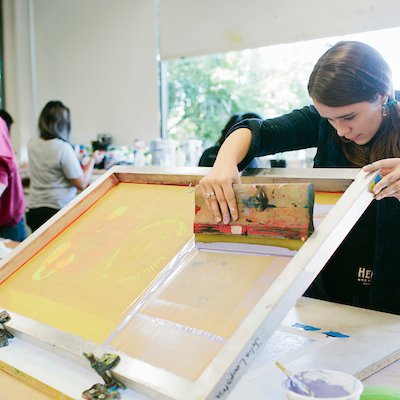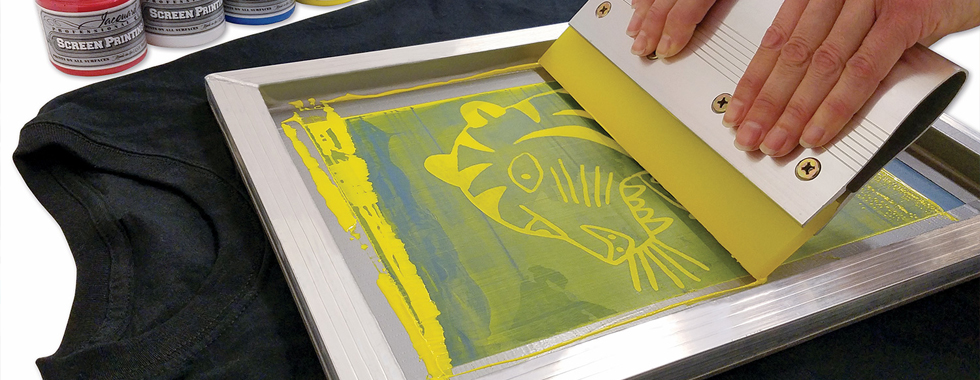ChatGPT said: 10:9 Design Screen Printing Texas: costs explained
Wiki Article
Discover the Various Kinds of Screen Printing Techniques for Your Following Job
Screen printing uses a varied series of methods that can boost any type of creative project. From standard approaches like serigraphy to contemporary technologies such as direct-to-garment printing, each approach has its unique benefits. Specialty options, including green and metal inks, introduce much more opportunities. Comprehending these strategies can significantly affect the last result. The challenge lies in choosing the most appropriate technique for certain needs and desired effects. What factors should one think about?
The Basics of Screen Printing
Screen printing may appear complex, it is basically an uncomplicated process that entails moving ink with a mesh screen onto different surfaces. The technique starts with the creation of a pattern, which specifies the style to be printed. This pattern is connected to a mesh screen, generally made from polyester or nylon. Once the stencil is in place, ink is used to the screen and pressed through the mesh using a squeegee, causing the desired pattern being published on the underlying product.Screen printing can be executed on a wide variety of substrates, including plastic, paper, and textile, making it a functional selection for various jobs. The process permits vivid colors and complex styles, making it preferred in industries such as art, fashion, and marketing. Understanding these basics furnishes individuals with the fundamental knowledge needed to discover advanced techniques in screen printing.
Conventional Screen Printing Techniques
Standard screen printing strategies have actually been utilized for centuries, preserving the workmanship and artistry of this method. This strategy utilizes a mesh screen to move ink onto a substrate, such as textile or paper, enabling dynamic and long-lasting layouts. The procedure begins with creating a stencil, which blocks specific locations of the screen to manage where the ink will be applied.One preferred method is serigraphy, commonly used for restricted editions and imaginative prints. One more is the use of water-based inks, which are environment-friendly and give a soft feeling on textiles - 10:9 Design Company. Furthermore, standard approaches can consist of hands-on printing, where artisans use ink with a squeegee, ensuring precision and focus to information
These techniques stay valued in the market for their responsive high quality and the unique appearances they create, attracting both customers and makers that value the heritage of screen printing.
Digital Screen Printing Innovations
As the need for faster manufacturing and personalization in the printing market has risen, electronic screen printing innovations have actually emerged as a game-changer. This technology blends typical screen printing techniques with electronic processes, enabling for rapid prototyping and complex styles that were previously hard to achieve. One considerable development is the intro of direct-to-garment (DTG) printing, which promotes premium, full-color prints on different textiles without the requirement for screens. Furthermore, developments in ink formulas have caused environment-friendly alternatives that maintain vivid shades while decreasing ecological effect. Making use of automated systems further improves manufacturing, lowering labor expenses and boosting precision. These advancements not just satisfy small batch orders and customized styles yet additionally enable for quicker turnaround times, making them perfect for businesses focused on conference client demands in a busy market. Digital screen printing, as a result, represents a necessary development in the domain name of printing strategies.Specialized Screen Printing Approaches
Discovering specialized screen printing techniques reveals a varied range of techniques that press the limits of imagination and functionality in the printing sector. Among these, glow-in-the-dark inks give an unique visual effect, making layouts come active in low-light problems. Metallic inks, recognized for their glittering coating, include a touch of deluxe to published materials. Another ingenious method is discharge printing, which eliminates dye from the material as opposed to adding ink, resulting in a soft, classic feeling. High-density printing develops an increased structure externally, enhancing tactile interaction. Furthermore, water-based inks are obtaining popularity for their vibrant shades and lowered ecological effect. Each of these specialty methods satisfies details style needs, enabling brand names and artists to develop standout products that reverberate with their audiences. By leveraging these methods, companies can boost their screen printing jobs to new elevations, making certain remarkable impacts.Eco-Friendly Screen Printing Options
Environment-friendly screen printing alternatives are acquiring traction as the sector changes towards sustainability. Sustainable ink choices and making use of eco-friendly products are essential elements in reducing the ecological effect of the printing procedure. By adopting these techniques, screen printers can add to an extra lasting future while maintaining top quality outcomes.Lasting Ink Options

Biodegradable Materials Usage
As the screen printing industry evolves, the incorporation of biodegradable materials is coming to be increasingly crucial for eco mindful techniques. Manufacturers and developers are currently discovering inks and substratums made from all-natural, eco-friendly resources that disintegrate a lot more successfully than standard counterparts. These eco-friendly alternatives minimize plastic waste and minimize ecological impact, straightening with the growing demand get more info for sustainable items.
Common examples include water-based inks and organic cotton materials, both of which decrease dangerous chemicals and advertise eco-friendliness. Brands that adopt these products commonly enhance their market allure, drawing in consumers who prioritize sustainability. As understanding of ecological problems remains to climb, the change in the direction of biodegradable materials in screen printing is most likely to gain momentum, fostering a greener industry standard.
Picking the Right Method for Your Job
Just how can one determine the most ideal screen printing strategy for a specific job? The choice pivots on several aspects, consisting of the material to be printed on, the complexity of the design, and the wanted manufacturing volume - 10:9 Design LLC Company. Direct-to-garment printing is ideal for detailed styles with numerous shades, while conventional screen printing succeeds for bigger runs of simpler graphics.
In addition, consideration of the end-use of the published item is vital. For exterior applications, methods that supply resilience and climate resistance, such as plastisol ink, may be chosen. Alternatively, environmentally-conscious tasks may take advantage of eco-friendly materials or water-based inks.
Eventually, comprehending the task's special demands enables an educated selection, making certain both aesthetic charm and useful long life. By evaluating design complexity, product compatibility, and manufacturing scale, one can properly select the most suitable screen printing technique to fulfill their job's objectives.
Often Asked Concerns
What Is the Background of Screen Printing?
Screen printing came from in ancient China around 1000 ADVERTISEMENT, developing via Japan and Europe. By the 20th century, it came to be preferred in business art and fashion, reinventing exactly how styles were created and dispersed around the world.
Just how Do I Prepare Art Work for Screen Printing?
To prepare art work for screen printing, one have to assure high resolution, use an ideal shade mode, develop separate layers for each and every color, and transform text to outlines, ensuring compatibility with the printing process and preferred outcome.What Products Are Finest for Screen Printing?
The finest products for screen printing consist of top quality inks, durable displays, and ideal substratums like cotton, polyester, or blends. Additionally, utilizing suitable solution and squeegees can improve the printing procedure and outcomes.Can I Screen Print at Home?
Yes, screen printing in the house is possible. With the right materials, arrangement, and strategies, people can develop high-quality prints. Mindful consideration of workspace and tools is essential for effective results.What Are Common Blunders in Screen Printing?
Typical errors in screen printing consist of incorrect exposure times, poor ink uniformity, misalignment of displays, insufficient cleansing of materials, and overlooking to evaluate prints. These mistakes can endanger the top quality and precision of the last item.Screen printing might appear complex, it is essentially a straightforward procedure that entails transferring ink through a mesh screen onto numerous surfaces. As the demand for faster production and modification in the printing market has surged, electronic screen printing advancements have arised as a game-changer. Discovering specialized screen printing methods discloses a varied range of strategies that push the boundaries of creative thinking and performance in the printing industry. The ideal products for screen printing include premium inks, resilient displays, and ideal substrates like cotton, polyester, or blends (10:9 Design near me). Typical mistakes in screen printing consist of inappropriate exposure times, inadequate ink uniformity, misalignment of displays, insufficient cleansing of products, and ignoring to test prints
Report this wiki page